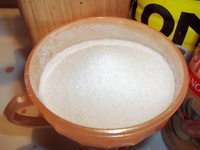Orange Lozenges (c. 1650)
This recipe for orange lozenges, documented by Lady Anne Percy around 1650, required its maker to have access to a network of exciting new imported foodstuffs, including sugar and oranges. The familiar oranges we eat today only gained prominence in the English diet in the 16th century with the formation of colonial networks extracting resources from the Americas for European consumption, as well as Portuguese interjection into the land and sea commercial trade routes linking prosperous southeast Asia with economic hubs in India, the East African coast, and the Middle East. While Spain and Morocco had grown and exported sour oranges bred from Persian varieties since the 11th century, European consumers craved the sweet variety shipped from occupied ports in southeast Asia and poured money into maritime exploration and subsequent occupation of land for orange-growing.
Percy's inclusion of instruction to serve the lozenges in glass reveals European aristocracy's unease with a growing merchant class newly able to purchase the luxury goods previously reserved by price for the aristocracy. Percy's focus on a food presentation that recommends glassware—a luxury good likely imported from wealthy Venice— reifies her credentials as a "real" member of the English upper class.
For more on the history of orange cultivation and trade, see The Origin of Oranges, ArcGIS Storymaps; Cynthia Graber, Nicola Twilley, and Gastropod, "The Secret History of Citrus," The Atlantic (19 April 2016); L. Ramón-Laca, "The Introduction of Cultivated Citrus to Europe via Northern Africa and the Iberian Peninsula," Economic Botany vol. 57 no. 4 (2003).
For more on the history of Venetian glassmaking and trade, see Matthew Martin, Liquid Light: 500 Years of Venetian Glass, NGV (5 March 2019); Michael L. Kunz and Robin O. Mills, “A Precolumbian Presence of Venetian Glass Trade Beads in Arctic Alaska,” American Antiquity 86, no. 2 (2021); Stefano Carboni, Trinita Kennedy, and Elizabeth Marwell, Venice and the Islamic World: Commercial Exchange, Diplomacy, and Religious Difference, Metropolitan Museum of Art (March 2007).
Transcription
First take your orenges & scrape them, then cut them in the midle and wring out the [juice?] and save it in a glasse, then water your pill in this manner, take 2 great pitcher potts of water, and set them in each corner of the chimeny, so that the water may be keept hott and not seeth, and when it is hott put your orenges into one of the potts, and when the water waxeth bitter poure it out, and put the water of the other pott into it, and so fill the other pott again that you may have water to shift as it waxeth bitter, and this you must do till the bitternesse be clean gone from them, then set your pott near the fire, and seeth them untill they be tender, then stampe them very small in a mortar of stone, with as many aples boiled tender as you have orenges, and when they are well mingled and beaten straine the [juice?] to them and mingle them altogether and sett them on a chaffindish of coales, and let them boile untill they be thick; in the mean time prepare your candy in this manner, take as much sugar as your orenges weigh, & put to it as much faire(?) water as will wett the sugar and some what more, then seeth it untill it will candy which you may know by laying a drop upon a dish side, for if it come of dry your candy is enough, then take your stuffe from the fire and mingle your candy annd that well together, then seeth it again on the coales and keep it stirring halfe an hower, then take it of and stirre it till it be halfe cold, then put it on plates and let it stand untill it be candyed on the topp, then cut it into Lossenges with a ruler and turne them. If you will you may lay your stuffe upon a glasse & fashion it as you please.
Translation
First take your oranges & scrape them, then cut them in the middle and wring out the [juice?] and save it in a glass. then water your pele in this manner: take 2 great pitcher pots of water and set them in each corner of the chimney so that the water may be kept hot and not boil. When it is hot, put your oranges into one of the pots, and when the water turns bitter pour it out and put the water of the other pot into it, and so fill the other pot again that you may have water to shift as it turns bitter. You must do this till the bitterness is entirely gone from them. Then set your pot near the fire and boil them until they are tender, then stamp them very small in a mortar of stone with as many apples as you have oranges, boiled until tender. When they are well-mixed and beaten, add the [juice?] to them and mingle them altogether and set them on a chafing dish of coals and let them boil until they thicken. In the meantime, prepare your candy in this manner: take as much sugar as your oranges weigh, & put to it as much fair(?) water as will wet the sugar and somewhat more, then boil it until it candies (which you may know by laying a drop upon a side dish, for if it comes off dry, your candy is enough). Then take your stuff from the fire and mingle your candy annd that well together, then boil it again on the coals and keep stirring it half an hour, then take it off and stir it until it half-cools, then put it on plates and let it stand until it candies on the top. Then cut it into lozenges with a ruler and turn them. If you want, you may lay your stuff upon a glass & fashion it as you please.



